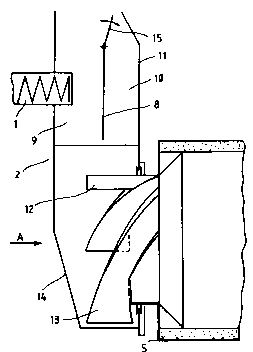Une partie des informations de ce site Web a été fournie par des sources externes. Le gouvernement du Canada n'assume aucune responsabilité concernant la précision, l'actualité ou la fiabilité des informations fournies par les sources externes. Les utilisateurs qui désirent employer cette information devraient consulter directement la source des informations. Le contenu fourni par les sources externes n'est pas assujetti aux exigences sur les langues officielles, la protection des renseignements personnels et l'accessibilité.
L'apparition de différences dans le texte et l'image des Revendications et de l'Abrégé dépend du moment auquel le document est publié. Les textes des Revendications et de l'Abrégé sont affichés :
| (12) Brevet: | (11) CA 2063390 |
|---|---|
| (54) Titre français: | SYSTEME D'ALIMENTATION POUR FOUR A CHAUX |
| (54) Titre anglais: | FEEDING SYSTEM FOR A LIME REBURNING KILN |
| Statut: | Durée expirée - au-delà du délai suivant l'octroi |
| (51) Classification internationale des brevets (CIB): |
|
|---|---|
| (72) Inventeurs : |
|
| (73) Titulaires : |
|
| (71) Demandeurs : |
|
| (74) Agent: | GOWLING WLG (CANADA) LLPGOWLING WLG (CANADA) LLP |
| (74) Co-agent: | |
| (45) Délivré: | 1995-08-08 |
| (86) Date de dépôt PCT: | 1990-06-28 |
| (87) Mise à la disponibilité du public: | 1991-01-04 |
| Requête d'examen: | 1991-12-30 |
| Licence disponible: | S.O. |
| Cédé au domaine public: | S.O. |
| (25) Langue des documents déposés: | Anglais |
| Traité de coopération en matière de brevets (PCT): | Oui |
|---|---|
| (86) Numéro de la demande PCT: | PCT/FI1990/000172 |
| (87) Numéro de publication internationale PCT: | WO 1991000251 |
| (85) Entrée nationale: | 1991-12-30 |
| (30) Données de priorité de la demande: | ||||||
|---|---|---|---|---|---|---|
|
A method and apparatus for heat treatment of lime mud com-
prises drying of the lime mud to be introduced into the lime reburn-
ing kiln (5) in a pneumatic dryer (3) by means of flue gases dis-
charged from the lime reburning kiln in order to regenerate the lime
content of the lime mud. From a drying filter (6), the lime mud
thickened to a dry solids content of over 75 %, preferably to 80 %, is
introduced into a feed chamber (2) through which an adjustable por-
tion of the flue gas is conducted. Depending on the gas amount, 100
% or less of the lime mud is entrained with the gas into the dryer (3),
the remaining portion falling into the lower section (14) of the feed
chamber, wherefrom it is further transferred into the lime reburning
kiln (5).
Note : Les revendications sont présentées dans la langue officielle dans laquelle elles ont été soumises.
Note : Les descriptions sont présentées dans la langue officielle dans laquelle elles ont été soumises.

2024-08-01 : Dans le cadre de la transition vers les Brevets de nouvelle génération (BNG), la base de données sur les brevets canadiens (BDBC) contient désormais un Historique d'événement plus détaillé, qui reproduit le Journal des événements de notre nouvelle solution interne.
Veuillez noter que les événements débutant par « Inactive : » se réfèrent à des événements qui ne sont plus utilisés dans notre nouvelle solution interne.
Pour une meilleure compréhension de l'état de la demande ou brevet qui figure sur cette page, la rubrique Mise en garde , et les descriptions de Brevet , Historique d'événement , Taxes périodiques et Historique des paiements devraient être consultées.
| Description | Date |
|---|---|
| Inactive : Périmé (brevet - nouvelle loi) | 2010-06-28 |
| Inactive : CIB de MCD | 2006-03-11 |
| Inactive : CIB de MCD | 2006-03-11 |
| Lettre envoyée | 2000-06-14 |
| Accordé par délivrance | 1995-08-08 |
| Exigences pour une requête d'examen - jugée conforme | 1991-12-30 |
| Toutes les exigences pour l'examen - jugée conforme | 1991-12-30 |
| Demande publiée (accessible au public) | 1991-01-04 |
Il n'y a pas d'historique d'abandonnement
| Type de taxes | Anniversaire | Échéance | Date payée |
|---|---|---|---|
| TM (brevet, 8e anniv.) - générale | 1998-06-29 | 1998-05-11 | |
| TM (brevet, 9e anniv.) - générale | 1999-06-28 | 1999-05-12 | |
| TM (brevet, 10e anniv.) - générale | 2000-06-28 | 2000-05-15 | |
| Enregistrement d'un document | 2000-05-18 | ||
| TM (brevet, 11e anniv.) - générale | 2001-06-28 | 2001-05-16 | |
| TM (brevet, 12e anniv.) - générale | 2002-06-28 | 2002-05-15 | |
| TM (brevet, 13e anniv.) - générale | 2003-06-30 | 2003-05-14 | |
| TM (brevet, 14e anniv.) - générale | 2004-06-28 | 2004-05-17 | |
| TM (brevet, 15e anniv.) - générale | 2005-06-28 | 2005-05-16 | |
| TM (brevet, 16e anniv.) - générale | 2006-06-28 | 2006-05-15 | |
| TM (brevet, 17e anniv.) - générale | 2007-06-28 | 2007-05-17 | |
| TM (brevet, 18e anniv.) - générale | 2008-06-30 | 2008-05-15 | |
| TM (brevet, 19e anniv.) - générale | 2009-06-29 | 2009-06-11 |
Les titulaires actuels et antérieures au dossier sont affichés en ordre alphabétique.
| Titulaires actuels au dossier |
|---|
| AHLSTROM MACHINERY OY |
| Titulaires antérieures au dossier |
|---|
| ARTO AHVENAINEN |